A plant aquarium is a beautiful addition to any room. With so many aquarium plant types out there, the sky’s the limit regarding aquascaping.
Adding fish to your aquarium can give it an extra pop of color and make the environment more active.
The fish listed in this article love aquariums with plenty of plants. Consider any of these for your planted tank to bolster its appearance and ecosystem simultaneously.
#1 Betta Fish (Betta splendens)
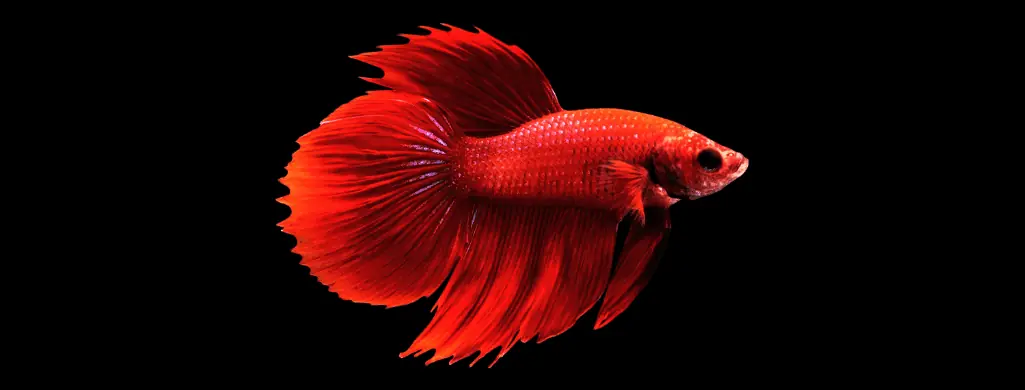
- Lifespan: 3 to 5 years
- Diet: Omnivore
- Care: Easy
- Best plants: Anacharis, Anubias, Java fern, Java moss, Frogbit, Driftwood
There are many types of betta fish originating in various parts of Southeast Asia.
Bettas are a popular freshwater fish. Fish keepers love them for their striking colors, attractive finnage, and ease of care.
Different types feature variations in tails, fins, body shape, and breeding rituals.
Most of the time, betta fish make good community aquarium fish. They get along well with smaller, peaceful creatures like snails, corydoras, and tetras.
Be careful never to house two male bettas together, as they will fight and possibly kill each other. It’s usually fine to house many females together in a sorority since they’re more peaceful.
Bettas enjoy tanks with plenty of plants, slow-moving water, and hiding places. Learn more about betta fish care in our comprehensive guide.
#2 Neon Tetra (Paracheirodon innesi)
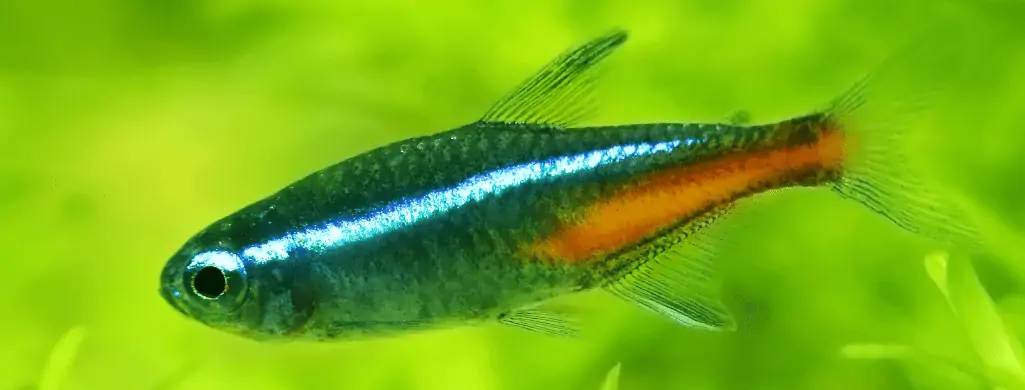
- Lifespan: 5 to 10 years
- Diet: Omnivorous
- Care: Intermediate
- Best plants: Floating plants, Driftwood
Neon tetras originate from Brazil, Columbia, and Peru.
They swim in the Orinoco and Amazon river basins, where the water is dark and full of plants. For this reason, captive neon tetras prefer environments with plenty of aquatic plants.
This is a popular fish option for new and experienced aquarists alike.
Many admire its beautiful appearance. This betta has a whitish belly and an iridescent blue stripe running across its body. There’s also a shorter red stripe.
Since neon bettas are peaceful fish, they’re perfect for community tanks.
Note: Remember to keep neon tetras in groups of six or more. This is how they live in their natural habitat and only thrive in groups.
#3 Cardinal Tetra (Paracheirodon axelrodi)

- Lifespan: 4 to 5 years
- Diet: Omnivorous
- Care: Intermediate
- Best plants: Floating plants, Driftwood
Another peaceful fish species, cardinal tetras, originate from Brazil, Colombia, and Venezuela. They prefer aquariums with low lighting and lots of plants.
They especially love floating plants.
Cardinal tetras look like neon tetras, but there is a key difference.
The red stripe on the cardinal tetra goes all the way across its body. On the neon tetra, it only goes about halfway across the body.
Like neon tetras, cardinal tetras must live in groups. They usually thrive in community tanks, as well.
#4 Rummy-nose Tetra (Hemigrammus bleheri)
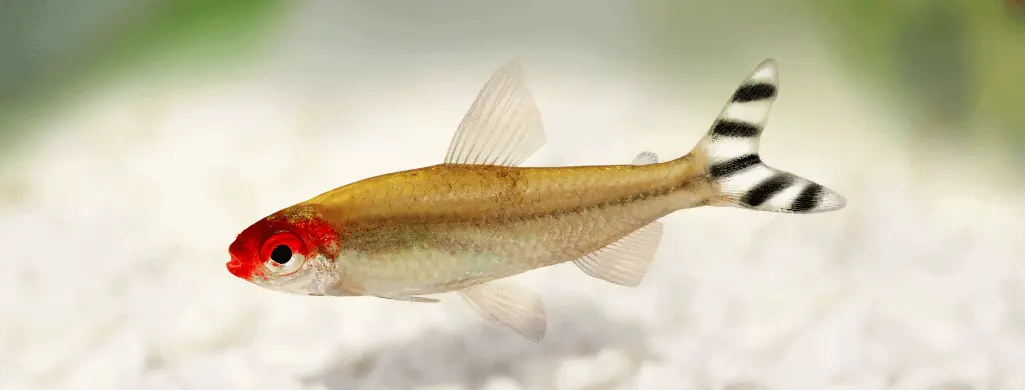
- Lifespan: 5 to 8 years
- Diet: Omnivorous
- Care: Intermediate
- Best plants: Catappa leaves, Driftwood
The rummy-nose tetra originates in South America, in the Amazon River. This means it prefers environments with plenty of foliage and dark hiding places.
It’s a beautiful fish with unique colorations and patterns. Its body is usually silver, though some rummy-nose tetras have albino or golden bodies.
They also have a reddish head and a tail with horizontal black-and-white stripes.
This is a common schooling fish, and it’s best to keep it in groups of six to twelve.
Keep in mind there are three varieties of rummy-nose tetras:
- True rummy-nose tetra (Hemigrammus rhodostomus)
- Firehead tetra (Hemigrammus bleheri)
- False rummy-nose tetra (Petitella georgiae)
Each type makes a great addition to the average planted community tank.
#5 Harlequin Rasbora (Trigonostigma heteromorpha)
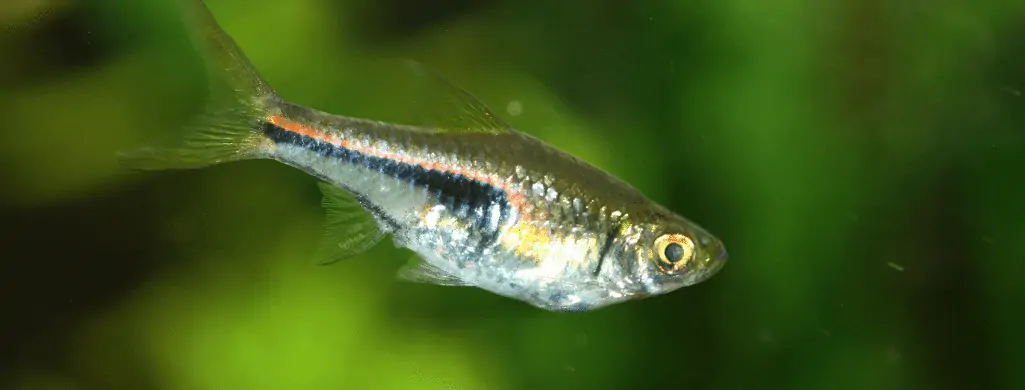
- Lifespan: About 6 years
- Diet: Omnivorous
- Care: Intermediate
- Best plants: Cryptocoryne, Driftwood
Harlequin rasboras are another popular option among fish keepers. They originate throughout Southeast Asia, especially in the following countries:
- Thailand
- Malaysia
- Sumatra
- Singapore
Harlequin rasboras thrive in planted aquariums since their natural environment includes plant-dense waters. They also prefer dim lighting.
These schooling fish feature reddish bodies with a black triangular patch. The patch is on their rear end. Fish keepers love the simple yet striking look.
Keep harlequin rasboras in groups of eight to 12 members. You may also house your rasboras in community tanks as long as the tank mates are small, peaceful fish.
# 6 Angelfish (Pterophyllum scalare)
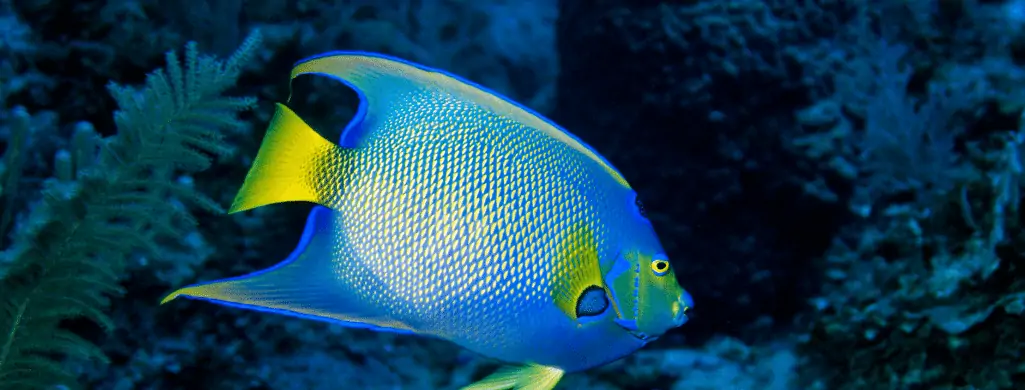
- Lifespan: 8 to 12 years
- Diet: Omnivorous
- Care: Intermediate
- Best plants: Floating plants, Broad leaf plants, Java fern, Driftwood
Angelfish come from the South American Amazon River system. They enjoy tanks featuring broad plant leaves and floating plants.
This is because they provide good cover and oxygenate the water.
This popular freshwater fish features a silvery body with dark vertical stripes. But many angelfish varieties exist, including koi, zebra, and leopard.
Fish keepers love angelfish for their striking body shape and elegant swimming movements.
Angelfish do well in community fish tanks but ensure their tank mates aren’t too small. Larger fish are less likely to get eaten.
Also, opt for tank mates of peaceful species to prevent fighting.
#7 Killifish (Nothobranchius furzeri)

- Lifespan: 2 to 5 years
- Diet: Carnivorous
- Care: Depends on variety
- Best plants: Depends on variety
Another popular freshwater fish, killifish, live in various locations worldwide. These include the Americas, Argentina, Japan, the Middle East, and even Africa.
These fish live in waters with plenty of plants and foliage. This makes them perfect for planted tanks.
It’s important to note there are several varieties of killifish. Each variety’s exact dietary and water condition needs will vary.
Also, each variety has unique colorations and patterns.
Also, avoid putting your killifish in community fish tanks with very small fish. While they’re not too aggressive, they have a habit of eating fish smaller than them.
#8 Lambchop Rasbora (Trigonostigma espei)
- Lifespan: 3 to 5 years
- Diet: Omnivorous
- Care: Easy
- Best plants: Microsorum, Taxiphyllum, Cryptocoryne, Anubias, Driftwood
The lambchop rasbora’s natural habitats include southwestern Thailand and parts of Cambodia. Lambchop rasboras prefer planted fish tanks mimicking their natural environment.
Lambchop rasboras are similar in appearance to the harlequin rasbora. But lambchop rasboras have a red-orange body and a more lambchop-shaped tail marking.
This is a popular fish species for those who are new to the fish-keeping game. They’re easy to care for and stunning to look at.
Since this is a peaceful fish species, it does well with most tank mates.
But remember to keep lambchop rasboras in groups of six or more. This both keeps them relaxed and tells larger tank mates not to attack.
#9 Cherry Barb (Puntius titteya)
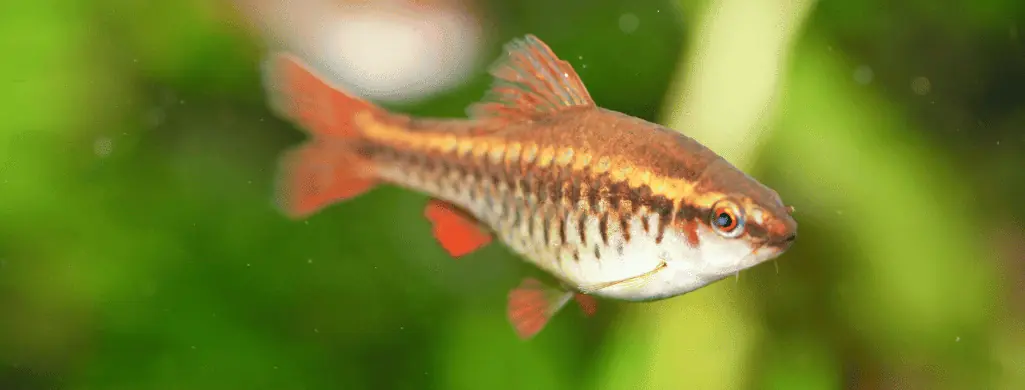
- Lifespan: 4 to 6 years
- Diet: Omnivorous
- Care: Easy
- Best plants: Java fern, Hornwort, Anacharis
Cherry barbs originate from Sri Lanka, where they enjoy the water with dense vegetation. This peaceful fish is a favorite among new and experienced aquarists alike.
It’s also perfect for community tanks.
This beautiful fish boasts a cherry-red body with a dark lateral stripe.
Males tend to display more vibrant colors than females do. Male cherry barbs’ colors also become brighter during mating season.
This type of fish does well in community fish tanks. Only house cherry barbs in schools of six or more, and opt for small and peaceful tank mates.
#10 Zebra Danio (Danio rerio)
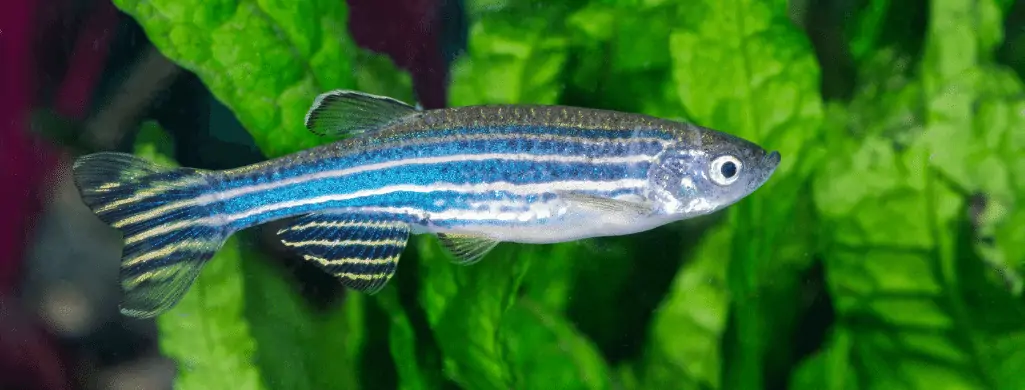
- Lifespan: 3 to 5 years
- Diet: Omnivorous
- Care: Easy
- Best plants: Java fern, Amazon sword, Driftwood
Zebra danios are hardy fish originating in India, Bangladesh, and Bhutan. They’re one of the easiest freshwater fish to care for, being able to thrive in a wide range of water parameters.
This popular freshwater fish comes in a variety of colors and patterns.
Most of them have silver-gold bodies and zebra stripes. These stripes are usually blue with a black outline, but they may also be other colors.
The most popular variety of zebra danios is the GloFish. They’re genetically altered to have different bright-colored bodies that glow in the dark.
Zebra danios are a wonderful option for community fish tanks. It’s best to house it with peaceful species, including other Danio varieties.
Also, zebra danios need to live together in groups of at least five.
#11 Pearl Danio (Brachydanio albolineatus)
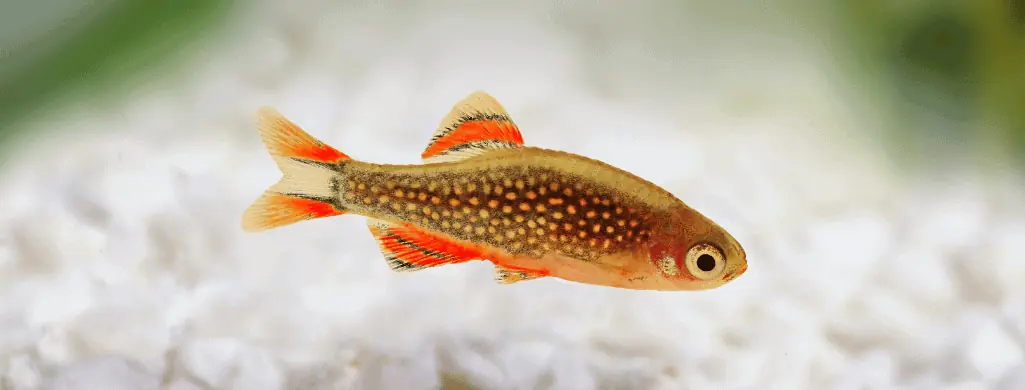
- Lifespan: 3 to 5 years
- Diet: Omnivorous
- Care: Easy
- Best plants: Fine-leaved plants
Pearl danios are another beautiful fish, popular among beginner and experienced aquarists. They originate in various parts of Southeast Asia, including Burma, Sumatra, and Thailand.
These fish feature slender, pearly-white, iridescent bodies.
Their iridescence is gorgeous to look at while they swim. It adds a simple yet striking aesthetic to any aquarium.
Pearl danios are one of the best varieties of freshwater fish for community tanks.
They’re small and peaceful, making them well-suited to most tank mates. Opt for those with low aggression levels to prevent fighting or bullying.
#12 Celestial Pearl Danio (Danio margaritatus)
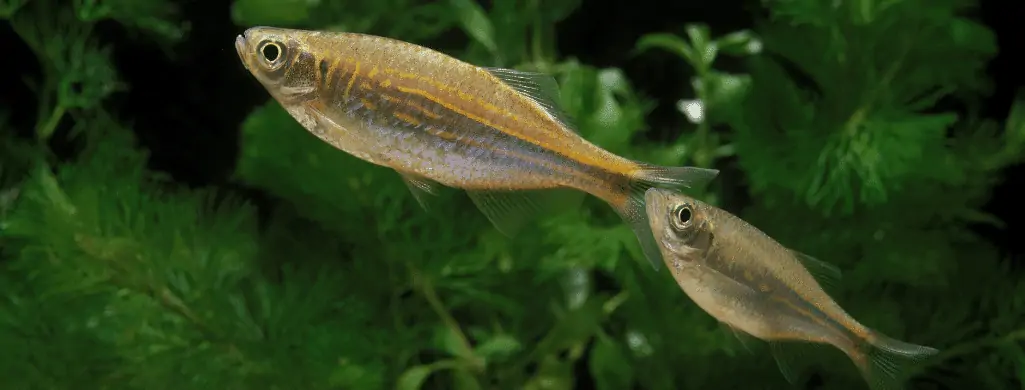
- Lifespan: 3 to 5 years
- Diet: Omnivorous
- Care: Intermediate
- Best plants: Java fern, Rotala, Bacopa, Floating plants
This popular schooling fish comes from Myanmar and northern Thailand. They prefer aquariums with plenty of plants and shallow, still water.
Celestial pearl danios boast striking colors and patterns. Most of them have blue bodies with yellowish spots, giving them the appearance of a galaxy.
For this reason, people often call them galaxy danios. They usually have reddish fins and tails.
This species is perfect for a community aquarium. Celestial pearl danios must live in schools of five or six fish. Also, their tank mates will need to be small and peaceful.
#13 White Cloud Mountain Minnow (Tanichthys albonubes)
- Lifespan: 3 to 5 years
- Diet: Omnivorous
- Care: Easy
- Best plants: Water Sprite, Water wisteria
Another popular fish for planted tanks is the White Cloud Mountain minnow. This species used to thrive in China and Vietnam, but it’s now an endangered species.
This is due to environmental factors and overharvesting.
This species of fish is perfect for beginners. White Cloud Mountain minnows are hardy fish. This means they can thrive in varying water conditions.
White Cloud Mountain minnows have a bronze-colored body with an iridescent horizontal stripe.
They also have an upturned mouth and a slightly protruding jaw. It’s a gorgeous option for any planted tank!
This species does well in community aquariums. Make sure to house them in schools of six or more, as this reduces anxiety and enhances their colors.
Also, avoid housing them with larger fish or those with high aggression levels. It may cause fighting, and your White Cloud Mountain minnow might get eaten.
#14 Dwarf Gourami (Trichogaster lalius)
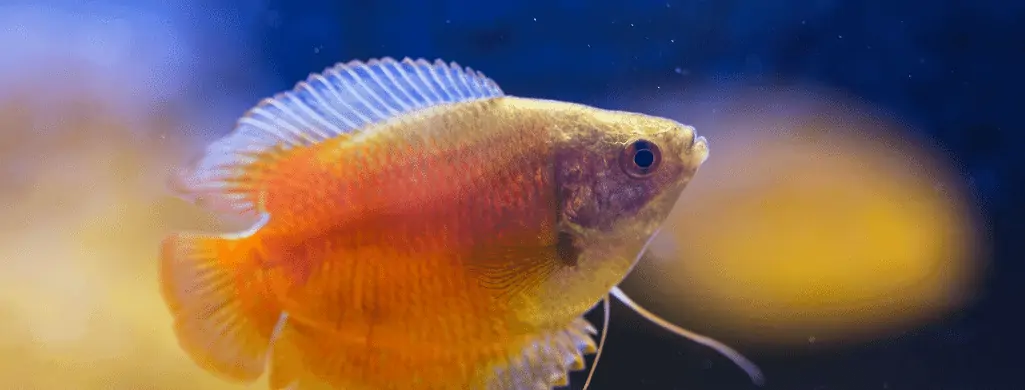
- Lifespan: 4 to 6 years
- Diet: Omnivorous
- Care: Intermediate
- Best plants: Floating plants, Java fern, Anubias
Dwarf gouramis originate from Pakistan, Assam, Bangladesh, India, and West Bengal.
This species has several different varieties, each with its unique colorations and patterns. The typical dwarf gourami has a light blue body with reddish stripes and some red coloration in the fins.
Also, like bettas, dwarf gouramis have sexual dimorphism.
This means males and females tend to have differences in appearance. Males tend to be larger and more vibrant than females.
This small and peaceful fish is a great addition to planted community tanks. Keep them in schools with other gouramis, and consider introducing other peaceful fish.
#15 Honey Gourami (Trichogaster chuna)

- Lifespan: 4 to 8 years
- Diet: Omnivorous
- Care: Easy
- Best plants: Floating plants (water wisteria, hornwort, water sprite)
Honey gouramis are beautiful fish originating in India and Bangladesh.
Their natural environment has still waters and lots of vegetation. This means honey gouramis enjoy tanks with ample aquarium plants.
These fish feature slender bodies and are a bit smaller than dwarf gouramis. They also exhibit sexual dimorphism, with males being larger and having more vibrant coloration.
Male honey gouramis have yellowish-orange bodies with fins rimmed with deep orange. Some have a slight blue tinge to their neck, as well.
This popular freshwater fish tends to thrive in community aquariums.
Unlike many of the other fish on this list, honey gouramis do not swim in schools. It’s best to keep a single one with small, peaceful fish.
#16 Sparkling Gourami (Trichopsis pumila)
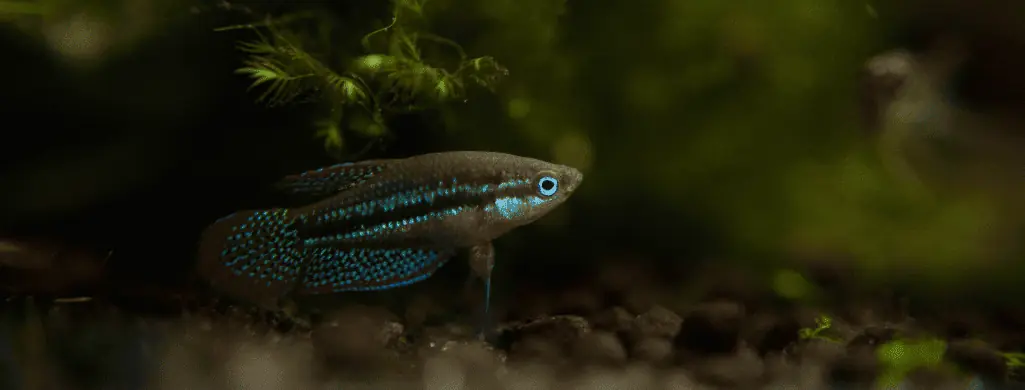
- Lifespan: 4 to 5 years
- Diet: Omnivorous
- Care: Easy
- Best plants: Floating plants (water wisteria, hornwort)
Sparkling gouramis originate in various areas throughout Southeast Asia. These include parts of Thailand, Vietnam, and Indonesia.
Its small size, peacefulness, and ease of care make it a great beginner fish.
This species has a brown-colored body featuring bluish or greenish spots. Its fins and tail boast gorgeous spot patterns and reddish rimming.
Sparkling gouramis do well in tanks with plenty of plants and some peaceful tank mates. This species is interesting, as it can live in schools, by itself, or with peaceful fish species.
#17 Kribensis (Pelvicachromis pulcher)
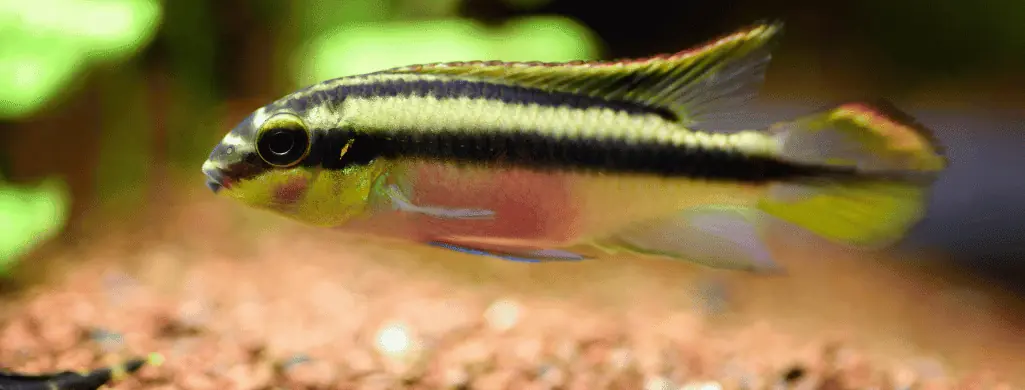
- Lifespan: Up to 5 years
- Diet: Omnivorous
- Care: Easy
- Best plants: Any
Kribensis originate in Nigeria and Cameroon, where they enjoy shallow and well-vegetated water.
Aquarists love this species for its incredible colors and typical cichlid body shape. Their bodies vary in color from deep gray to albino.
They feature a dark, prominent stripe that runs from the mouth to the caudal fin. Their fins also have orange-red rims.
Female kribensis also have a gorgeous pink-red bellies. There are kribensis available in a range of colors and patterns, but this is the most typical.
Kribensis are good fish for community tanks and are sometimes kept in pairs.
If adding tank mates, opt for those with peaceful demeanors. Also, kribensis display fin-nipping, so avoid keeping them with long-finned fish.
#18 German Blue Ram (Mikrogeophagus ramirezi)
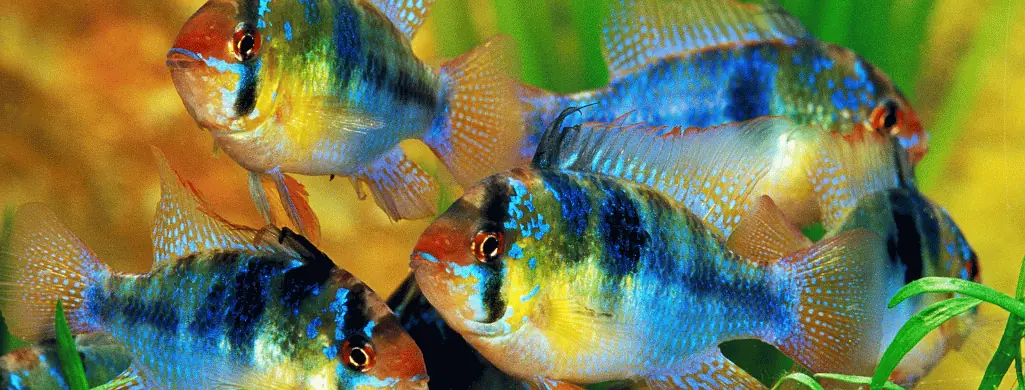
- Lifespan: Up to 4 years
- Diet: Omnivorous
- Care: Intermediate
- Best plants: Floating plants, Java fern, Mosses, Driftwood, Catappa leaves
The German blue ram is another favorite with rich colors and fascinating patterns. This species originates in Venezuela and Colombia, especially in the Amazon basin.
Generally, German blue rams have a pale-colored body of silver, gold, or yellow. The dorsal fin is usually black, while the rest of the fins are yellow or red in color.
This fish boasts blue spots throughout its body, including on the tail and fins. Other defining features are the dark line that passes over the fish’s eye and the dark splotch of color on the body.
This beautiful fish thrives in aquariums with plenty of plants and does well with tank mates. Ensure the tank mates you include are peaceful and roughly the same size as your German blue ram.
#19 Corydoras Catfish (e.g., Corydoras panda, Corydoras sterbai)

- Lifespan: 5+ years
- Diet: Omnivorous
- Care: Easy
- Best plants: Java fern, Java, moss, Hornwort, Amazon sword, Hornwort
There are several varieties of corydoras catfish originating from South America.
Each variety has simple care requirements and lovely colorations and patterns. A few of the most common varieties include albino, emerald, panda, and pygmy.
These peaceful catfish are an optimal choice for any planted community fish tank. They tend to dwell near the bottom of the tank, where they’re unlikely to bother tank mates.
Opt for tank mates with similar peaceful temperaments. Also, ensure they’re of a similar size to your corydoras.
#20 Otocinclus Catfish (Otocinclus spp.)
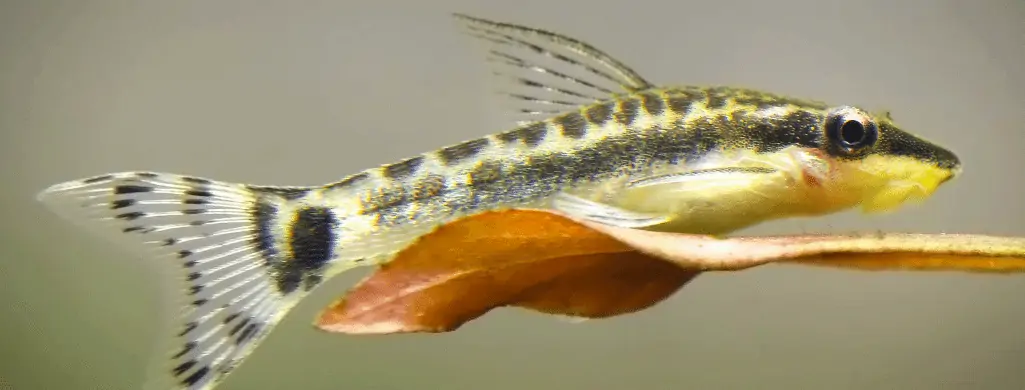
- Lifespan: 3 to 5 years
- Diet: Herbivore
- Care: Easy
- Best plants: Java fern, Java moss, Anubias, Cryptos
Otocinclus catfish are a great choice for any tank. They originate in South America, especially in Venezuela and Argentina.
This means they enjoy calm, vegetated waters.
Like with corydoras, there are several varieties of otocinclus catfish.
These include common, zebra, golden, and dwarf. Each one has its unique physical characteristics, though their care requirements are similar.
Oto catfish have algae-eating tendencies and tend to be most active at night.
They do well in community tanks, especially with other peaceful catfish of a similar size. They also enjoy the company of certain snail populations.
Fish such as tetras and cherry barbs are good tank mate options, too.
#21 Bristlenose Pleco (Ancistrus spp.)

- Lifespan: 5 to 15 years
- Diet: Herbivore
- Care: Easy
- Best plants: Any, Driftwood
Bristlenose plecos are most common in the Amazon River basins. Their preference for slow-moving and vegetated water makes them ideal for planted aquariums.
These plecos look a bit odd compared to other common aquarium inhabitants.
In particular, their noses have “bristles,” or long appendages, growing on them. They also have a wider head than other pleco varieties.
There are a few different bristlenose pleco varieties:
- Albino
- Longfin
- Super red
- Starlight
- Calico
Bristlenose plecos are well-suited to life in community fish tanks. Consider housing them with other plecos, peaceful snail populations, or gentle freshwater fish.
#22 Siamese Algae Eater (Crossocheilus oblongus)
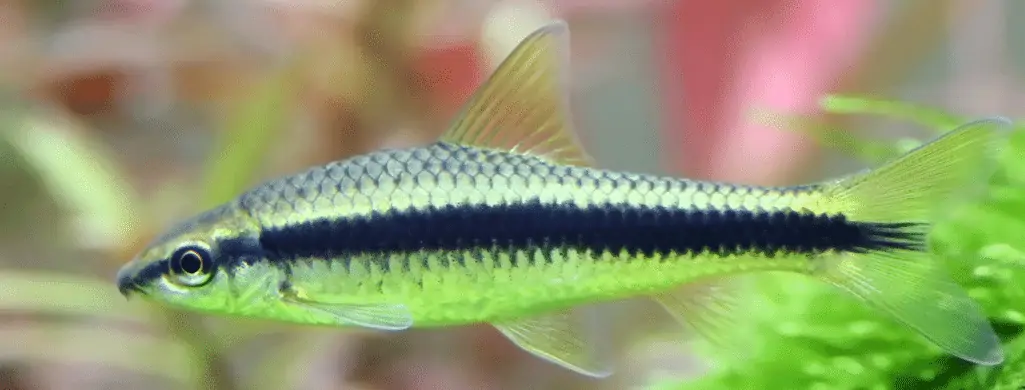
- Lifespan: Up to 10 years
- Diet: Omnivore
- Care: Easy
- Best plants: Fast-growing (hornwort, anacharis, water wisteria), Driftwood
Siamese algae eaters originate in Southeast Asia, particularly in Thailand and Malaysia.
These fish are simple but beautiful in appearance. Their bodies are usually silver or gold, and they have a prominent black stripe running from nose to tail.
Fish keepers also love their gentle nature and small size — perfect for a community fish tank. Siamese algae eaters can live alongside most other freshwater species.
Be careful not to house them with aggressive fish. Also, opt for tank mates that are not also bottom dwellers for the best results.
Here’s our list of fast-growing aquarium plants that pair well with this fish and bettas too!
#23 Guppies (Poecilia reticulata)

- Lifespan: Up to 3.5 years
- Diet: Omnivore
- Care: Beginner
- Best plants: Any
One of the most popular freshwater fish, guppies, originate in South America. This is a very beginner-friendly fish with easy care requirements.
Different guppy varieties have variations in color and pattern.
Popular colors include yellow, orange, red, and silver. Guppies are rather small and slender with gorgeous flowing tails. Their tails are often multi-colored and feature magnificent patterns.
While guppies do make a good community tank fish, be cautious when choosing tank mates. Opt for peaceful species, such as corydoras, tetras, or snails.
Another option is to house a bunch of guppies together.
#24 Endler’s Livebearer (Poecilia wingei)
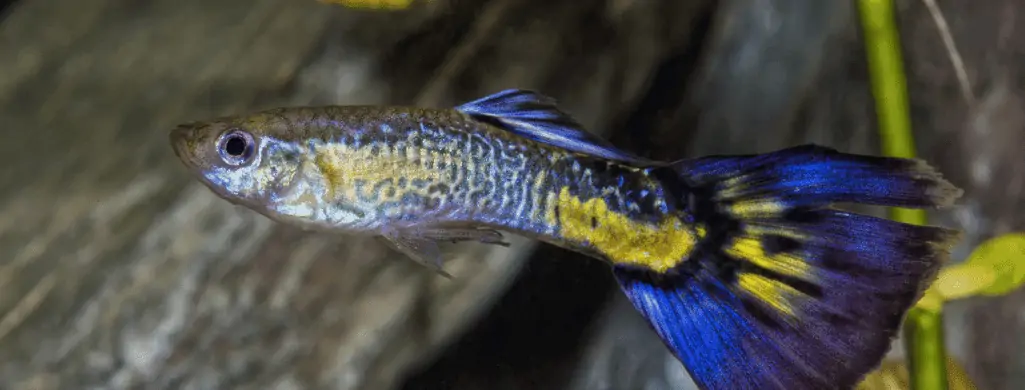
- Lifespan: 1 to 3 years
- Diet: Omnivore
- Care: Easy
- Best plants: Java fern, Water wisteria, Water sprite, Duckweed, Guppy grass
The Endler’s livebearer originates in Venezuela. This fish is currently endangered due to low population levels.
Most Endler’s livebearers available in stores are captive-bred.
Fish keepers love Endler’s livebearers for their vibrant colors. Males feature an overlaying of various colors, including blues, greens, reds, and oranges.
Females are usually one solid color (a silvery color).
This is an ideal community fish due to its small size and peaceful demeanor. It gets along with other peaceful freshwater creatures like corydoras, snails, and tetras.
Upgrade Your Betta Aquarium With The Perfect Fish
There are several varieties of freshwater fish suited to join your betta in its planted tank. From corydoras to gouramis, these fish create a more colorful and diverse tank.
Keep following us for more practical information on betta care and aquarium upkeep.


